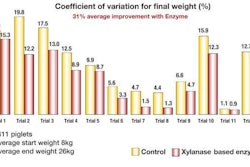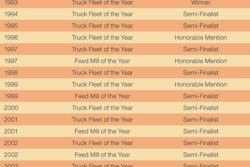.jpg?auto=format%2Ccompress&q=70&w=400)
For anyone in Europe wanting to find future directions in poultry diet design, the place to look this year was the city of Strasbourg on the border between France and Germany. It hosted a gathering of top feed specialists from all parts of the continent and further afield to discuss the latest indications from research and practice.
The occasion was the 16th European Symposium on Poultry Nutrition. This international conference is held every two years under the auspices of the European Federation of the World's Poultry Science Association or WPSA, always in a different country. In 2007, the honor of arranging the program fell to the members of WPSA France.
They chose European and North American guest speakers with expertise on the processing of feeds as well as on dietary composition to meet estimated requirements. Among the subjects in the feed-processing area were the control of bacterial contamination of feedstuffs and the improvement in nutritive value obtainable from attending to particle size.
As this latter paper from Norway's Professor Birger Svihus confirmed, the hot topic of the moment has to be the influence of diet factors on so-called gut health. An example from broilers has been the demonstration that grinding feeds too finely, so that their particles are excessively small, is both wasteful on energy and counterproductive for the bird by interfering with the proper development of the gizzard.
It was put into perspective at the meeting when Feed International spoke to Jackie Linden, who is editor of our associated journal Poultry International. She emphasized that nutritional manipulation to optimize gut health had become a European quest across all monogastric feeding in the aftermath of the Europe-wide ban on including antibiotic growth promoter (AGP) supplements in feeds.
"The prohibition continues to shape ideas on nutrition, almost two years after it was introduced," she remarked. "By general consent again among the people attending the symposium in Strasbourg, we should not expect one single replacement or so-called ‘magic bullet' to fill the gap left by the AGP removal. The way forward probably involves employing a series of different strategies according to particular conditions and objectives."
So while the poultry nutritionists of Europe still must take account of the fundamentals ranging from the growth rate and final value of broiler chickens to the egg output of laying hens, their focus now also extends to the maintenance of bird well-being by attending to the interaction between the feed and the bird's digestive tract. This orientation already has produced a wealth of new knowledge about the physical form of the gut and the microbiota that are its inhabitants.
Early establishment of microflora
Just how far the know-how has advanced in recent years was underlined by a Strasbourg presentation by Dr Richard Ducatelle of the University of Ghent in Belgium. The knowledge is considerable, he commented, although we are just now learning. An example from his group's research has found that short-chain fatty acids inhibit mucosal invasion by Salmonella and increase the resistance of epithelial cells to invasion by Campylobacter. Butyrate seems to be particularly important. It follows that dietary changes which stimulate butyrate production in the lower digestive tract (or possibly feeding a coated formulation) could play a role in reducing food-borne illness. Early establishment of an adult microflora should be the aim, according to Dr Ducatelle.
"However," Poultry International's editor continued, "it would be wrong to think that the concentration on bird health begins and ends with the gut. We have heard a number of examples during the symposium in which diet was linked more widely to health status.
"Perhaps the most intriguing in this respect related to the feeding of broiler breeders. Feed companies sometimes forget these birds are a part of the poultry universe as if their numbers are too small to make a viable market, but on average there is one broiler breeder bird for every 100 broiler chickens in commercial production. Our own annual Executive Guide to World Poultry Trends tells us that over 48 billion broilers were produced worldwide last year, so you can see the breeding flock behind them must have consumed a considerable amount of feed.
"The aim of the latest nutritional research on breeders described at this meeting has been to try to transfer nutrient factors from hen to chick. It recognizes that the chick soon after hatching eats very little and therefore must rely on extracting sustenance from the yolk sac. With this in mind, transfer should probably work better for fat-soluble nutrients as they will need to enter the fatty yolk.
"The people doing the research say they hope both vitamins and minerals can be transferred from maternal nutrition as an aid to progeny performance. They target in particular the vitamins D and E together with selenium, zinc and manganese. In theory, these should be of benefit to the chick's immune system."
Feeding for behavior control
At another level, the Strasbourg presentations raised the possibility of feeding for the control of behavior. Behavioral aspects impact directly on performance and profitability.
The clearest illustration of this came in a paper from the University of Wageningen in the Netherlands, where Marinus van Krimpen and colleagues have been investigating the Behavioral vice of feather-pecking that affects egg layers. There is general agreement that the vice is important economically because pecked birds tend to have inferior laying performance and also are unsuitable for normal processing when culled.
"The causes of feather-pecking still need to be fully explained, but it seems to be misplaced natural behavior," Jackie Linden commented. "Birds will quite normally investigate their surroundings by pecking at any object within range. They peck at the feathers of other members of the group if there is nothing else to occupy them. This is probably why fewer reports of feather pecking involve free-range birds than those in caged housing. Pullets and layers kept outside usually have other diversions.
"Experts also think there is a genetic effect. The egg markets of the world are divided clearly between white- and brown-shelled eggs. It is the brown-feathered layers that are more susceptible to serious incidents of feather-pecking.
"Of course if you work in a brown-egg market you are going to have brown layers, you do not have the choice of switching to the use of a white-feathered breed so that fewer birds will be pecked. But it is clear that feed composition can help to reduce the incidence of the vice. The Dutch team here have suggested that the principal aim in altering the layer diet should be to extend the feeding time. A hen will be less inclined to peck feathers if it is still eating.
"It becomes a question of bulk. They talked about using coarsely ground NSPs [non-starch polysaccharides] for this purpose, reporting moderate success from the manipulation. A good source of digestible fiber appears to assist by providing greater satiety or gut-fill. There may be a way to re-arrange formulation to accommodate a change of this type without sacrificing nutritional content. That will be one of the challenges to be resolved by further research."



.jpg?auto=format%2Ccompress&fit=crop&h=167&q=70&w=250)













